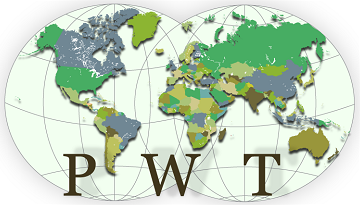The question why some countries are richer than others is of enduring interest for academics and policymakers. In the search for causes and potential solutions to worldwide inequality, the Penn World Table (PWT) has been a standard data source on differences in standards of living across countries, for over four decades. The latest release, version 10.01, provides data for 183 countries for the period 1950-2019.
PWT makes comparisons of levels of income and productivity using data on purchasing power parities, which is important for the outcomes, reflects substantial measurement effort and requires caution in use and interpretation.
We illustrate what can be learned from PWT data with two analyses. First, we carry out a development accounting exercise, which decomposes each country’s labour productivity level into contributions of production factors and total factor productivity. Second, we analyse convergence in labour productivity, and investigate to what extent countries with initially lower levels of GDP per hour worked, subsequently show faster labour productivity growth and the sources of that labour productivity growth.
Development Accounting
Development accounting decomposes cross-country income differences into contributions from production factors, such as human and produced capital, and (residual) differences in total factor productivity (TFP). While method this does not provide a causal explanation of income differences, it can help zoom in on the proximate causes of growth and development, for example, why human capital or produced capital differs across countries (e.g., Hsieh and Klenow, 2010). For the development accounting exercise, we follow the method by Inklaar et al. (2019).
In our illustration, we look at how much of the difference in GDP per hour worked relative to the USA in the year 2017 can be attributed to three key factors: (a) produced capital, (b) human capital, and (c) TFP. Produced capital covers equipment, structures and other capital formation, human capital reflects the level of educational attainment in the labour force, and TFP constitutes the part of GDP per hour worked that cannot be accounted for by the other factors of production and is often associated with technological factors and resource allocation across firms and industries.
Since the three contributions add up to the (difference in) GDP per hour worked, the slopes of the trend lines add up to 100 percent. So, each individual slope can be viewed as the percent contribution to overall differences in GDP per hour worked. For this sample of countries, 61 percent of the labour productivity difference with the USA can be attributed to TFP. Produced capital, at 16.5 percent, and human capital, 22.6 percent, both account for much less of the labour productivity difference.
To give a better understanding of this figure, let us take two countries for comparison purposes: the United Kingdom and Tanzania. As the figure shows, 2017 labour productivity in the United Kingdom was $54.68 per hour, a productivity difference with the USA of –27%, in log terms. The contributions of produced capital (+9.6%), human capital (+0.5%), and TFP (–37.1%), sum up to this difference. Tanzania has a labour productivity of $3.12 per hour in 2017, a productivity differential with the USA of –313.2%, again, in log terms. This can be decomposed into the contributions of Produced Capital (–40.9%), human capital (–79.4%) and TFP (–192.9%). For both countries the contribution of TFP makes the largest contribution to the labour productivity difference with the USA.
As a diagnosis for why GDP per hour worked differs, this analysis provides only a first and proximate view. But for Tanzania and the United Kingdom, TFP differences loom largest, as they do for most countries. This points to the importance of, first, resource allocation, such as an inefficiently large agricultural and/or informal sector in lower-income countries or a lack of competitive pressure that weeds out unproductive firms. Second, technological factors may be important, such as the diffusion of (international) best practices.
Convergence in labour productivity growth and its determinants
While the development accounting exercise focuses on understanding cross-country labour productivity differences at a single point in time, one might also wonder whether these differences are increasing or decreasing with time. More specifically, it might be useful to see whether poor countries are catching up to the richer countries. One way to answer this question is to test whether countries that initially had a lower level of labour productivity, subsequently show faster labour productivity growth, a concept also known as beta-convergence. For a discussion on this topic, see for example, Barro and Sala-i-Martin (1991), Young et al. (2008), Barro (2015).
Using the latest PWT data, the figure above illustrates the results on beta-convergence for the period 1990-2019. Panel (a) shows that on average, countries with a lower level of GDP per hour work experienced higher growth rates in labour productivity, as evidenced by the negative slope of the trend line (–0.21%). The trend line has been calculated on a log 2 scale, which means that for every doubling of the initial level of GDP per hour on the x-axis, average annual growth of GDP per hour on the y-axis is on average 0.21% lower.
The three remaining panels in the figure show how this convergence result can be decomposed into the contributions of the same three factors considered in the development accounting exercise: b (produced) capital per unit of output; c human capital; d TFP.
The sum of the slopes of these three factors add up to the slope of panel (a). The main takeaway from this graph is that, similar to the Development Accounting exercise, TFP with a slope of –0.40% has been the main contributing factor to labour productivity convergence. The slope for human capital is much flatter (-0.07%), indicating that it contributes less to the overall convergence in labour productivity. In contrast, capital per unit of output is the only contributing factor that has a positive slope (+0.26%), indicating that countries with higher levels of labour productivity added produced capital at a faster rate than those with lower levels, making this a force of divergence rather than convergence. In terms of significance, though, the slope for produced capital is the only one not significantly different from zero at conventional levels, which implies that we cannot rule out that capital accumulation has been a broadly neutral force in accounting for the convergence of labour productivity.
History of the Penn World Table
The PWT was initially created by Robert Summers and Alan Heston at the University of Pennsylvania.1 Since PWT version 8, the development of this database has been carried out by the University of California, Davis and the University of Groningen, while still maintaining the PWT name and benefiting from ongoing input from Alan Heston at the University of Pennsylvania. Gross Domestic Product (GDP) is the standard measure used when comparing income levels. While GDP data are available for all countries in the world from data sources such as the UN National Accounts, the distinctive feature of PWT is that it uses purchasing power parities (PPPs) to convert countries’ GDP estimates into a common currency. This allows for comparisons of GDP that correct for differences in the cost of living across countries.
Why do we need PPPs?
As each country reports GDP in their own currency, to properly measure income differences across countries, GDP must be converted into a common currency. One way to do this is to use market exchange rates, for example transforming local currency GDP estimates into U.S. dollars. However, market exchange rates reflect (at best) differences in prices of internationally traded goods and services. Prices of non-traded products are generally lower in less developed countries. For example, a haircut is much more expensive in the United Kingdom than in Tanzania, while the price of rice varies much less. A GDP conversion using market exchange rates would thus underestimate the relative income levels for less developed countries.
One explanation for why the price of non-tradables rises as a country develops is because of the Balassa-Samuelson2 effect. As countries develop, productivity growth in sectors producing traded goods is typically faster than in sectors producing non-traded goods. This will lead to rising wages in the traded sector. Assuming wages are equalized across sectors in the economy, wages will also rise in the non-traded sector, leading to higher prices there.
To address this we use purchasing power parities (PPPs), which include prices of traded and non-traded products and reflect the relative importance of each product in GDP. The PPP between country A and B indicates how much of country A’s currency would have to be converted into that of country B to buy the same amount of goods and services in each country. For example, if the price of a hamburger is £3 in London and €6 in Luxembourg, this would imply a PPP exchange rate of 1 pound to 2 euros. This hamburger price comparison is based on the widely known “Big-Mac” index, created by The Economist which tracks the price of the iconic McDonald’s hamburger which is sold all over the world.
How to measure PPPs?
Detailed PPPs are collected periodically by the International Comparisons Program (ICP), a statistical initiative managed by the World Bank. This occurs every few years, with the last benchmark round covering the year 2017 and the next round, with data for 2021, is expected to be released at the end of 2023. The items for which prices are collected are chosen from a common basket of goods and services, where this basket is constructed through collaborative efforts of national, regional and global agencies. Currently, the ICP calculates PPPs for 155 groups of similar well-defined goods and services (basic headings), for example rice and taxi services. PWT uses data from ICP and combines these with estimates of PPPs for exports and imports to arrive at GDP PPPs. These aggregate PPPs are used to convert values in national currency to internationally comparable values which have been corrected for cross-country price differences.
Which measure of ‘real GDP’?
In analysing GDP over time, it is important to account for changing prices over time to focus on the change in GDP volume. We use the same logic for comparing GDP across countries, accounting for differences in PPPs (i.e., prices across countries) to focus on differences in the volume of GDP. For an individual product (an apple, a Big Mac, a haircut), this does not raise issues, since the price of that product can be compared equally well across countries and over time. At an economy-wide level, issues do emerge. For conceptual as well as practical reasons, two subsequent measures of PPPs tend to be inconsistent with relative inflation over that same period of time. For this reason, PWT has several measures of ‘real GDP’ (as well as capital and TFP), each appropriate for a particular context or question. The most important distinction is between the GDP series based on National Accounts trends, which is most suited for analysing growth over time, and the GDP series based on different PPP series, which is most suited for analysing income differences at a point in time. In the development accounting analysis, we use the GDP, capital and TFP series based on different PPP series (denoted in PWT with the prefix ‘c’). In the beta-convergence analysis we use the same GDP series for the initial labour productivity level but we use the National Accounts-based series (denoted with the suffix ‘na’) for the growth rates of labour productivity, capital and TFP. The series for labour and human capital do not suffer from the inconsistency discussed here.
Notes:
1Summers, and Heston (1988), Summers and Heston (1991), Heston and Summers (1996).
2Balassa (1964), Samuelson (1964).
References:
Balassa, B. (1964). The Purchasing-Power Parity Doctrine: A Reappraisal. Journal of Political Economy, 72(6), 584–596. JSTOR.
Barro, R. J., & Sala-i-Martin, X. (1991). Convergence across States and Regions. Brookings Papers on Economic Activity, 22(1), 107-182.
Barro, R. J. (2015). Convergence and Modernisation. The Economic Journal, 125(585), 911–942.
Feenstra, R. C., Inklaar, R., & Timmer, M. P. (2015). The Next Generation of the Penn World Table. American Economic Review, 105(10), 3150–3182.
Heston, A., & Summers, R. (1996). International Price and Quantity Comparisons: Potentials and Pitfalls. The American Economic Review, 86(2), 20–24. JSTOR.
Hsieh, C.-T., & Klenow, P. J. (2010). Development Accounting. American Economic Journal: Macroeconomics, 2(1), 207–223.
Inklaar, R., Woltjer, P., Albarrán, D. G., & Gallardo, D. (2019). The composition of capital and cross-country productivity comparisons. International Productivity Monitor, 36(36), 34-52.
Inklaar, R., Marapin, R., Woltjer, P., & Timmer, M. (2022). Inconsistencies in Cross-Country Price Comparisons over Time: Patterns and Facts. In D. Chotikapanich, A. N. Rambaldi, & N. Rohde (Eds.), Advances in Economic Measurement: A Volume in Honour of D. S. Prasada Rao (pp. 633–663). Springer Nature Singapore.
Samuelson, P. A. (1964). Theoretical Notes on Trade Problems. The Review of Economics and Statistics, 46(2), 145.
Summers, R., & Heston, A. (1988). A new set of international comparisons of real product and price levels estimates for 130 countries, 1950–1985. Review of income and wealth, 34(1), 1-25.
Summers, R., & Heston, A. (1991). The Penn World Table (Mark 5): An Expanded Set of International Comparisons, 1950–1988*. The Quarterly Journal of Economics, 106(2), 327–368.
Young, A. T., Higgins, M., & Levy, D. (2008). Sigma Convergence versus Beta Convergence: Evidence from U.S. County-Level Data. Journal of Money, Credit and Banking, 40(5)


